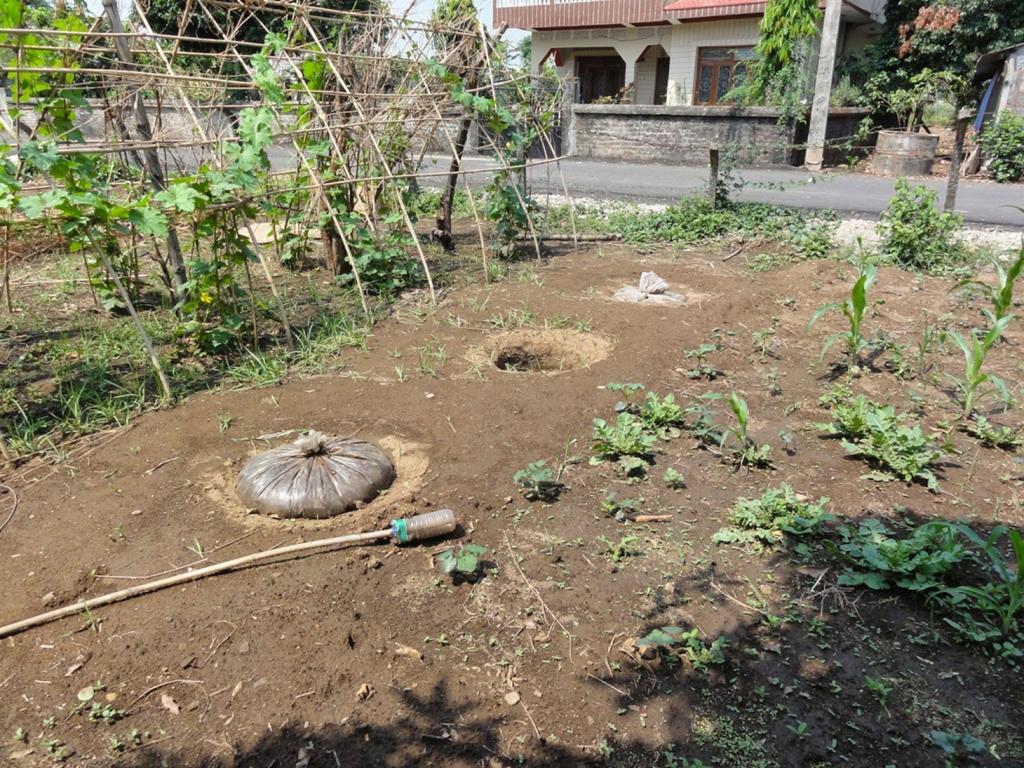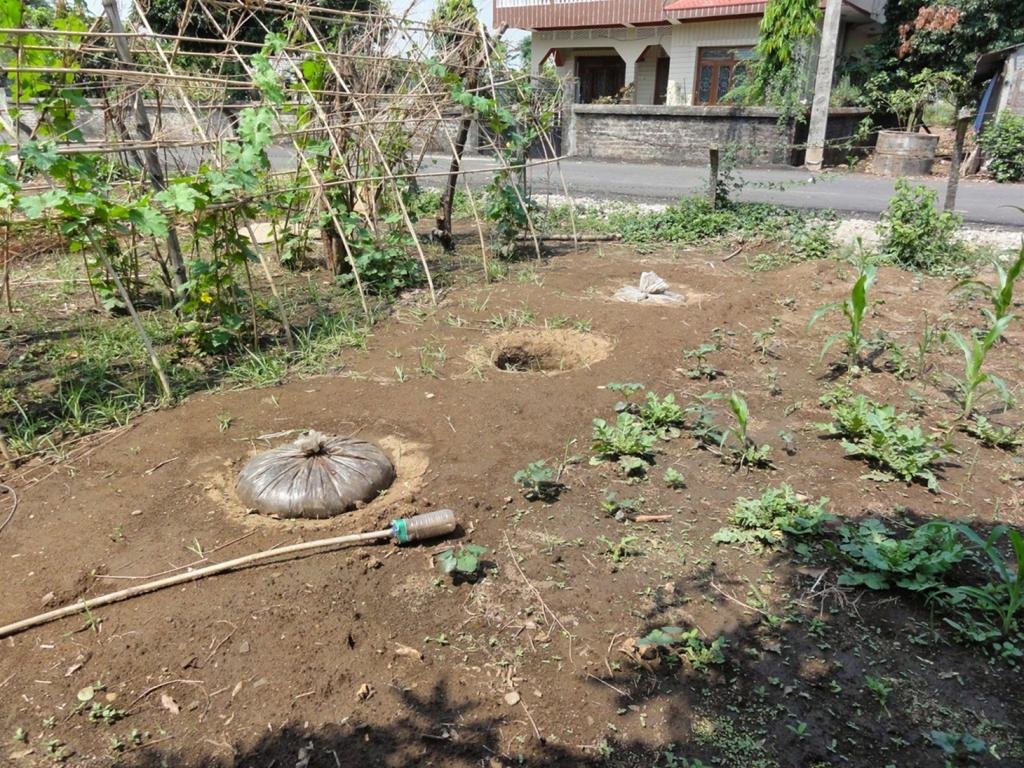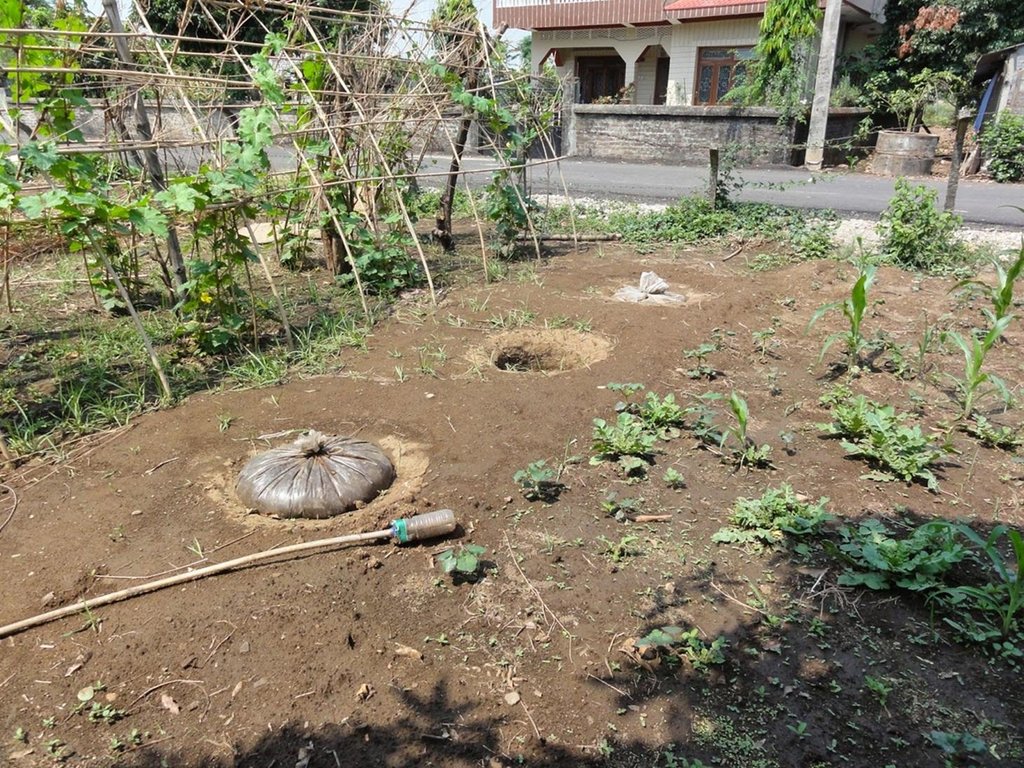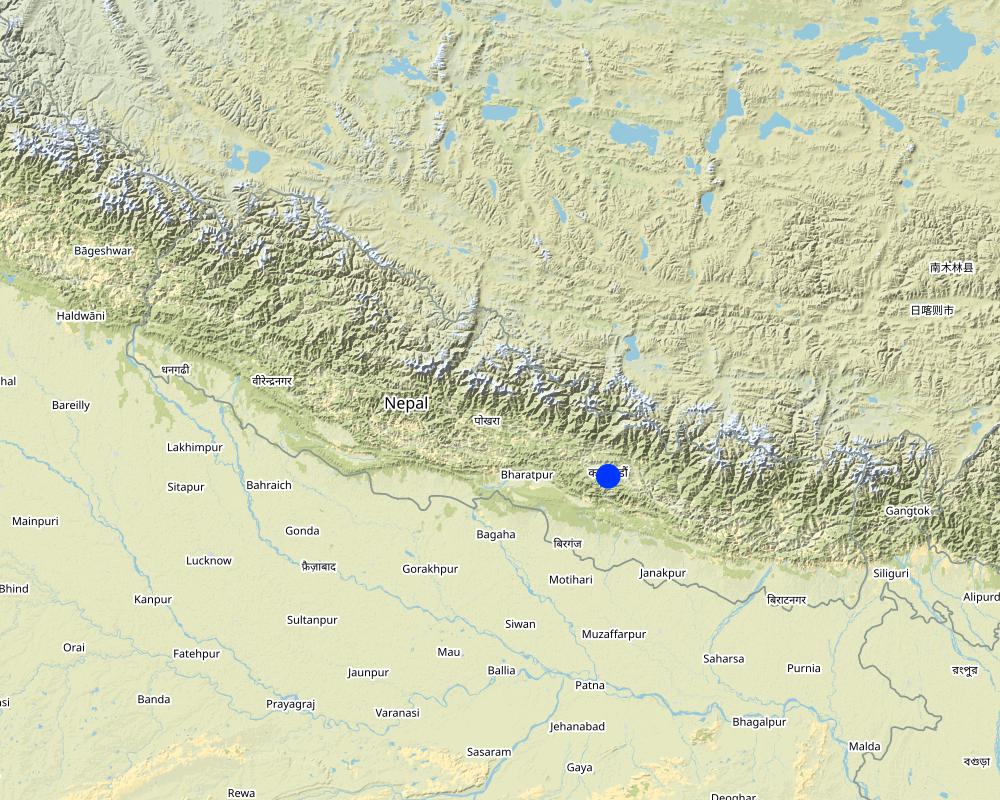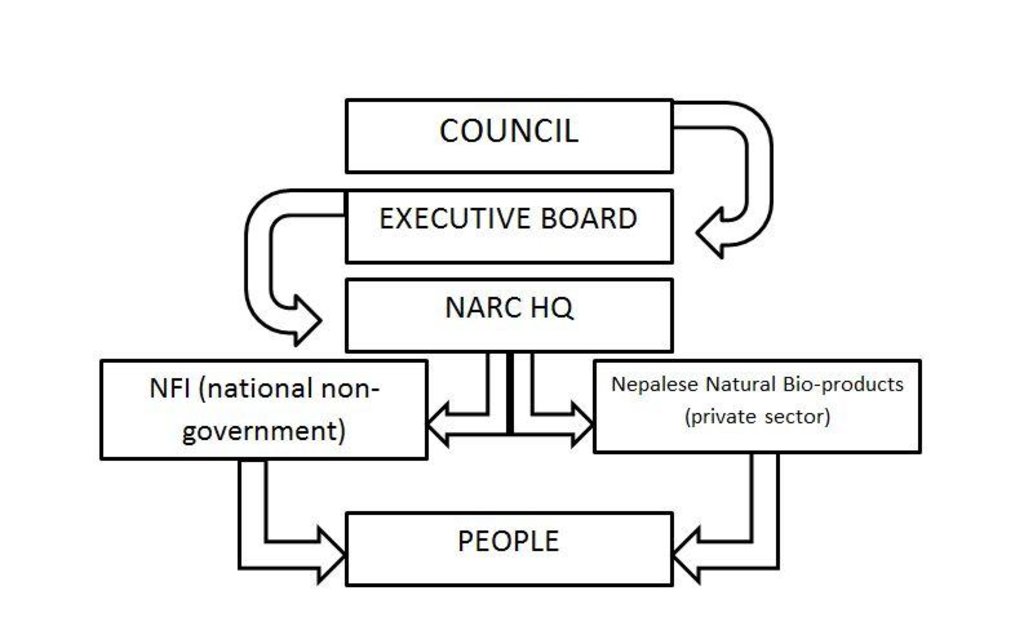Benefits of Jeevatu in crop production and protection [เนปาล]
- ผู้สร้างสรรค์:
- การอัพเดท:
- ผู้รวบรวม: Sabita Aryal
- ผู้เรียบเรียง: –
- ผู้ตรวจสอบ: Fabian Ottiger, Joana Eichenberger
Jevatu
approaches_2484 - เนปาล
ดูส่วนย่อย
ขยายทั้งหมด ย่อทั้งหมด1. ข้อมูลทั่วไป
1.2 รายละเอียดที่ติดต่อได้ของผู้รวบรวมและองค์กรที่เกี่ยวข้องในการประเมินและการจัดเตรียมทำเอกสารของแนวทาง
ผู้เชี่ยวชาญ SLM:
Sherpa . C Tenzing
Kathmandu University
Kavre, Nepal
เนปาล
ผู้เชี่ยวชาญ SLM:
Pradhan Ozal
Kathmandu University
Kavre, Nepal
เนปาล
ผู้เชี่ยวชาญ SLM:
Poudyal Bharat Kumar
Central Vegetation seed production center
เนปาล
ชื่อของโครงการซึ่งอำนวยความสะดวกในการทำเอกสารหรือการประเมินแนวทาง (ถ้าเกี่ยวข้อง)
Kathmandu University (KU) - เนปาล1.3 เงื่อนไขที่เกี่ยวข้องกับการใช้ข้อมูลที่ได้บันทึกไว้ผ่านทาง WOCAT
วันที่เก็บรวบรวมข้อมูล (ภาคสนาม):
22/09/2011
ผู้รวบรวมและวิทยากรหลักยอมรับเงื่อนไขเกี่ยวกับการใช้ข้อมูลที่ถูกบันทึกผ่านทาง WOCAT:
ใช่
2. คำอธิบายของแนวทาง SLM
2.1 การอธิบายแบบสั้น ๆ ของแนวทาง
Beneficial uses of Jeevatu in crop production and protection.
2.2 การอธิบายอย่างละเอียดของแนวทาง
การอธิบายอย่างละเอียดของแนวทาง:
Aims / objectives: The use of Jeevatu has been and still is solely for agricultural purpose. The main objective of it is to effectively free the environment different poisonous chemicals that are present in the form of pesticides and fertilizers.
It aims to prevent and control pests and diseases, including bacterial, viral and fungal, in vegetables, cereals, flowers and fruit trees, and to improve the growth of the plant, the yield and the quality of the fruits (vitamin content and peel thickness).
It can also be used to keep different fruits and vegetables fresh for a longer period of time.
Jeevatu further helps by promoting the proper management of the waste materials as the key ingredient in the process of producing Jeevatu is different organic wastes.
It provides an advantage to the farmers by an economic point of view as well - the cost of Jeevatu is comparatively much less than that of other pesticides and fertilizers.
Methods: A 2 feet wide and 1 foot long pit is dug in a fertile land.
A plastic sheet is placed in the pit
Raw cow dung and water is poured in the pit and made greasy
The 1m25cm plastic sheet is then made air and water tight by tying it up with a jute rope
Every 2-3 days water is added and the mixture is stirred well
The water added amounts up to about 50L.
After 17-25 days , a green colour is seen in the outer surface of the plastic bag and the odor is no longer present, this indicates that the fertilizer (Jeevatu) is now ready to be used.
The plastic bag is then removed and a new plastic sheet is placed to start the production of a new batch of Jeevatu
1L of the previous made Jeevatu is also included to after the second batch to gain a better yield of Jeevatu.
Role of stakeholders: There are mainly two types
The producers-
They seek profit in terms of money as they plan to produce good amounts of Jeevatu and sell them to the people involved in agriculture or animal husbandry
The people involved in agriculture and animal husbandry-
They seek profit in terms of good yield of crops or animal products. The use of Jeevatu benefits them and keeps them as well as the environment safe.
2.3 รูปภาพของแนวทาง
2.5 ประเทศ ภูมิภาค หรือสถานที่ตั้งที่ได้นำแนวทางไปใช้
ประเทศ:
เนปาล
ภูมิภาค/รัฐ/จังหวัด: :
Nepal
ข้อมูลเฉพาะเพิ่มเติมของสถานที่ตั้ง:
Lalitpur
Map
×2.7 ประเภทของแนวทาง
- ใช้โครงงานหรือแผนงานเป็นฐาน
2.8 เป้าหมายหรือวัตถุประสงค์หลักของแนวทาง
The Approach focused mainly on SLM with other activities (animal husbandry, can also be used in kitchen, toilets, remove bad odors)
To learn how Jeevatu was made
To learn how Jeevatu was made available to the people
To learn how much the people knew about it
To learn the benefits it had in the field of agriculture and animal husbandry
The SLM Approach addressed the following problems: Most people involved in agriculture and animal husbandry are not economically and financially strong. Hence the solution of financial and economic related problems should be given top priority.
2.9 เงื่อนไขที่เอื้ออำนวยหรือเป็นอุปสรรคต่อการนำเทคโนโลยีภายใต้แนวทางนี้ไปปฏิบัติใช้
การมีไว้ให้หรือการเข้าถึงแหล่งการเงินและบริการ
- เป็นอุปสรรค
Jeevatu is a local production, even though there is a specific group of people who produce it and distribute in the market as the methods to produce Jeevatu can be considered simple. Due to this reason other companies and people don’t show much interest in investing in it, hence there is low financial support.
Treatment through the SLM Approach: If Jeevatu can be produced in a large scale, it will gradually be recogzied worldwide, hence more financial assistances would be there and the constraint would be eliminated.
กรอบแนวทางในการดำเนินการด้านกฎหมาย (การถือครองที่ดิน สิทธิในการใช้ที่ดินและน้ำ)
- เอื้ออำนวย
The existing land ownership, land use rights / water rights greatly helped the approach implementation: community ownership meant no hindrance to development.
ความรู้เกี่ยวกับ SLM การเข้าถึงการสนับสนุนด้านเทคนิค
- เป็นอุปสรรค
There is lack of technology use
Treatment through the SLM Approach: If by some way technology can be introduced in the making of Jeevatu, the production would be quicker, better and more reliable.
3. การมีส่วนร่วมและบทบาทของผู้มีส่วนได้ส่วนเสียที่เกี่ยวข้อง
3.1 ผู้มีส่วนได้ส่วนเสียที่เกี่ยวข้องในแนวทางนี้และบทบาท
- ผู้ใช้ที่ดินระดับท้องถิ่นหรือชุมชนระดับท้องถิ่น
Farmers like Kalpana KC of Emadole, Lubu
Mainly used by farmers to enhance the crop productivity and its protection. Comparatively more economically disadvantaged groups were involved than socially disadvantaged ones. This is due to the cheap price of Jeevatu, i.e. only Rs.100 per bottle. Jeevatu being cheaper than other chemicals enabled the people of different economic groups to have better agricultural products.
- องค์กรที่ขึ้นอยู่กับชุมชน
People involved in agricultural works and animal husbandry
- ผู้เชี่ยวชาญ SLM หรือที่ปรึกษาการเกษตร
- องค์กรพัฒนาเอกชน
Nepalese Farming Institutes
- ภาคเอกชน
Nepalese Natural Bioproducts & different nurseries
- รัฐบาลแห่งชาติ (ผู้วางแผน ผู้ทำการตัดสินใจ)
NARC
ถ้ามีผู้มีส่วนได้ส่วนเสียหลายคนที่เกี่ยวข้องให้ระบุหน่วยงานตัวแทน:
Dr Bharat Kumar poudyal, Senior vegetable Development officer
3.2 การเกี่ยวข้องของผู้ใช้ที่ดินระดับท้องถิ่นหรือชุมชนระดับท้องถิ่นในช่วงต่างๆของแนวทาง
| ความเกี่ยวข้องของผู้ใช้ที่ดินระดับท้องถิ่นหรือชุมชนระดับท้องถิ่น | ระบุผู้ที่มีส่วนเกี่ยวข้องและอธิบายกิจกรรม | |
|---|---|---|
| การริเริ่มหรือการจูงใจ | ไม่มี | |
| การวางแผน | ไม่มี | |
| การดำเนินการ | ไม่มี | |
| การติดตามตรวจสอบหรือการประเมินผล | ไม่ลงมือ | self |
| Research | ไม่ลงมือ | About 15 Nepalese scientists of NFI developed this package of beneficial microbes after 25-30 yrs of research with the consultation & experimentation with several farmers and landusers. |
3.3 แผนผังแสดงขั้นตอนการทำงาน (ถ้ามี)
คำอธิบาย:
The flowchart shows how Jeevatu is made avaiable to the people.
Jeevatu was first made in NARQ HQ, the production was further continued by non governmental organizations such as NFI.
Different private sectors are also involved in funding of Jeevatu production.
The local people or farmers can get access to Jeevatu through these non governmental organizations and private sectors
ผู้เขียน:
Ozal Pradhan
3.4 การตัดสินใจเลือกใช้เทคโนโลยี SLM
ระบุผู้ที่ทำการตัดสินใจเลือกเทคโนโลยีมากกว่าหนึ่งวิธีไปปฏิบัติใช้:
- ผู้เชี่ยวชาญ SLM เป็นผู้ตัดสินใจหลัก ที่ติดตามให้คำปรึกษากับผู้ใช้ที่ดิน
การอธิบาย:
Around 15 Nepalese scientist of NFI developed this package of beneficial microbes after 25-30 yrs of research with the consultation & experimentation with several farmers.
4. การสนับสนุนด้านเทคนิค การสร้างขีดความสามารถ และการจัดการด้านความรู้
4.1 การสร้างขีดความสามารถ / การอบรม
ได้มีการจัดอบรมให้แก่ผู้ใช้ที่ดินหรือผู้มีส่วนได้ส่วนเสียคนอื่น ๆ หรือไม่:
ใช่
ให้ระบุว่าใครเป็นผู้ได้รับการอบรม:
- ผู้ใช้ที่ดิน
รูปแบบการอบรม:
- เกษตรกรกับเกษตรกร
- ใช้พื้นที่ทำการสาธิต
- จัดการประชุมสู่สาธารณชน
หัวข้อที่พูด:
The people who received trainings and had gained awareness involved those related to agriculture or animal husbandry.
They were told about the benefits of Jeevatu over the other chemicals and other important facts about how the chemicals cause harm to our bodies and the environment were also mentioned.
4.2 การบริการให้คำแนะนำ
ผู้ใช้ที่ดินมีการเข้าถึงการรับบริการให้คำปรึกษาหรือไม่:
ใช่
การอธิบาย/แสดงความคิดเห็น:
Advisory service is inadequate to ensure the continuation of land conservation activities; Government and other advisory services are not yet adequate as the message flow, regarding benefits of Jeevatu, is not proper. Only limited people are aware of it and a large number of communities are still using other harmful chemical pesticides and fertilizers.
4.3 การเสริมความแข็งแกร่งให้กับสถาบัน (การพัฒนาองค์กร)
สถาบันได้รับการจัดตั้งขึ้นมาหรือเสริมความแข็งแกร่งโดยแนวทางนี้หรือไม่:
- ใช่ เล็กน้อย
ระบุระดับของสถาบันที่ได้รับการเสริมความแข็งแกร่งหรือจัดตั้งขึ้นมา:
- ท้องถิ่น
ระบุประเภทของการให้ความช่วยเหลือสนับสนุน:
- การสร้างขีดความสามารถ / การอบรม
ให้รายละเอียดเพิ่มเติม :
Trainings were provided to the local communities in order to enlighten them about the benefits of the use of Jeevatu and to enable them to provide such awareness to other nearby local communities.
4.4 การติดตามตรวจสอบและประเมินผล
การติดตามตรวจสอบและประเมินผลเป็นส่วนหนึ่งของแนวทางหรือไม่:
ใช่
ความคิดเห็น:
area treated aspects were monitored by government through observations
no. of land users involved aspects were monitored by other through observations
There were no changes in the Approach as a result of monitoring and evaluation
4.5 การวิจัย
การวิจัยเป็นส่วนหนึ่งของแนวทางหรือไม่:
ใช่
ระบุหัวข้อเรื่อง:
- สังคมวิทยา
ให้ข้อมูลเพิ่มเติมและให้ระบุผู้ทำการวิจัย:
Research was carried out on-farm
5. การสนับสนุนด้านการเงินและวัสดุอุปกรณ์
5.1 ระบุงบประมาณประจำปีสำหรับแนวทาง SLM นี้
แสดงความคิดเห็น (แหล่งของการระดมทุน ผู้บริจาคคนสำคัญ):
Approach costs were met by the following donors: government (NARC); national non-government (NFI); private sector (Nepalese Natural Bio-products)
5.2 การสนับสนุนด้านการเงิน / วัสดุอุปกรณ์ให้แก่ผู้ใช้ที่ดิน
ผู้ใช้ที่ดินได้รับการสนับสนุนด้านการเงิน / วัสดุอุปกรณ์ไปปฏิบัติใช้เทคโนโลยีหรือไม่:
ใช่
5.3 เงินสนับสนุนสำหรับปัจจัยนำเข้า (รวมถึงแรงงาน)
ถ้าแรงงานโดยผู้ใช้ที่ดินเป็นปัจจัยนำเข้าที่มีอยู่มากมาย ระบุด้วยว่าเนื่องจาก:
- สมัครใจ
ความคิดเห็น:
Also some cash reward
5.4 เครดิต
มีการจัดหาเครดิตมาให้ภายใต้แนวทาง SLM หรือไม่:
ไม่ใช่
6. การวิเคราะห์ผลกระทบและการสรุป
6.1 ผลกระทบของแนวทาง
ช่วยให้ผู้ใช้ที่ดินนำเอาเทคโนโลยี SLMไปใช้และบำรุงรักษาสภาพไว้ได้หรือไม่:
- ไม่ใช่
- ใช่ เล็กน้อย
- ใช่ ปานกลาง
- ใช่ อย่างมาก
People, after the approach, acquired different information regarding the harms due to the extensive use of chemical pesticides and fertilizers and also learnt how Jeevatu had a significant advantage over them. It resulted in reduction of the use of those harmful chemicals and hence greatly promoted sustainable land management.
ทำให้กลุ่มด้อยโอกาสมีอำนาจทางสังคมและเศรษฐกิจหรือไม่:
- ไม่ใช่
- ใช่ เล็กน้อย
- ใช่ ปานกลาง
- ใช่ อย่างมาก
Jeevatu is available for just Rs.100 per bottle. This enabled the economically disadvantaged groups to take active part in using Jeevatu, increasing their agriculture yield and hence contribute to sustainable land management.
ปรับปรุงประเด็นของการถือครองที่ดินหรือสิทธิในการใช้ ซึ่งขัดขวางการนำเทคโนโลยีไปใช้ให้ดีขึ้น:
- ไม่ใช่
- ใช่ เล็กน้อย
- ใช่ ปานกลาง
- ใช่ อย่างมาก
there was no hindrance. The problem is likely to be overcome in the near future. approach creates a framework to use in the future.
Did other land users / projects adopt the Approach?
- ไม่ใช่
- ใช่ เล็กน้อย
- ใช่ ปานกลาง
- ใช่ อย่างมาก
Nearby local communities also adopted Jeevatu as the message was transferred through the local people.
Did the Approach lead to improved livelihoods / human well-being?
- ไม่ใช่
- ใช่ เล็กน้อย
- ใช่ ปานกลาง
- ใช่ อย่างมาก
The production of Jeevatu helped in the proper management of different organic materials The agricultural yield was greatly increased The amount of deterioration of land was significantly reduced
Did the Approach help to alleviate poverty?
- ไม่ใช่
- ใช่ เล็กน้อย
- ใช่ ปานกลาง
- ใช่ อย่างมาก
Jeevatu was affordable by people of economic status; this resulted in increase in their crop yield and hence alleviated poverty to a certain level
6.2 แรงจูงใจหลักของผู้ใช้ที่ดินเพื่อที่จะนำ SLM ไปปฏิบัติใช้
- การผลิตที่เพิ่มขึ้น
to improve agriculture and animal husbandry by the use of Jeevatu
- กำไร (ความสามารถ) อัตราส่วนค่าใช้จ่ายต่อผลประโยชน์ที่เพิ่มขึ้น
increase production helps in increasing profit.
- ภาระงานลดลง
helps to reduce large workload.
- well-being and livelihoods improvement
by increasing profits, it helps to improve the livelihood of farmers.
6.4 จุดแข็งและข้อได้เปรียบของแนวทาง
| จุดแข็ง / ข้อได้เปรียบของแนวทางในทัศนคติของผู้ใช้ที่ดิน |
|---|
| It has inceased the net profit. (How to sustain/ enhance this strength: If the price can be further lowered, then it can be more efficient.) |
| จุดแข็ง / ข้อได้เปรียบของแนวทางในทัศนคติของผู้รวบรวมหรือวิทยากรหลัก |
|---|
|
1) helps to preserve crop production as well as its protection. 2) Helps in composting, treating plant diseases. 3) Jeevatu also helps in waste management. 4) It helps to reduce the filthy smells of boars, dung and other animals. 5) Jeevatu helps in treating different plants related diseases. (How to sustain/ enhance this strength: Jeevatu is a local productio.So,if it introduced globally, then it can be commercialized and many people can be benefitted by its result. By its proper use as instructed by the experts.) |
6.5 จุดอ่อน / ข้อเสียเปรียบของแนวทางและวิธีในการแก้ไข
| จุดอ่อน / ข้อเสียเปรียบในทัศนคติของผู้รวบรวมหรือวิทยากรหลัก | สามารถแก้ไขปัญหาได้อย่างไร |
|---|---|
| Approach was based on small communities which made the information flow very limited | such awareness projects should be developed at a large scale basis to spread the message effectively |
7. การอ้างอิงและการเชื่อมต่อ
7.1 วิธีการหรือแหล่งข้อมูล
- ไปเยี่ยมชมภาคสนาม การสำรวจพื้นที่ภาคสนาม
- การสัมภาษณ์กับผู้ใช้ที่ดิน
ลิงก์และโมดูล
ขยายทั้งหมด ย่อทั้งหมดลิงก์
ไม่มีลิงก์
โมดูล
ไม่มีโมดูล


